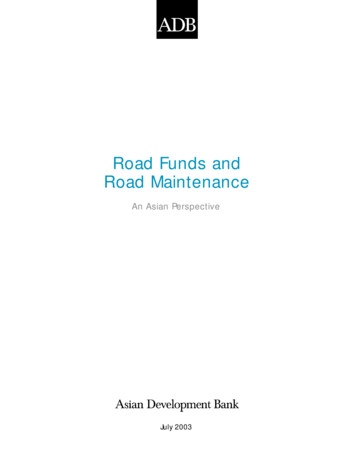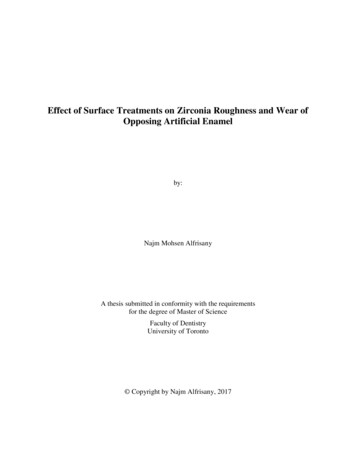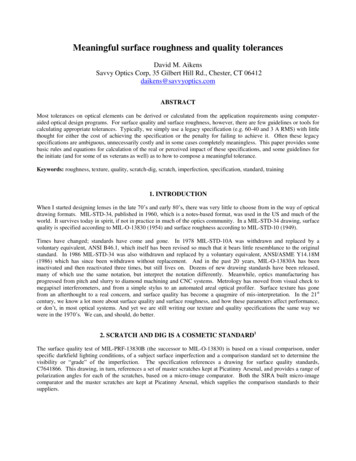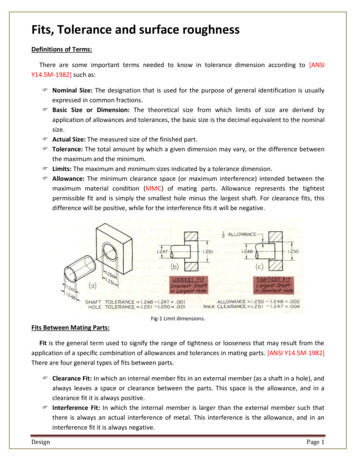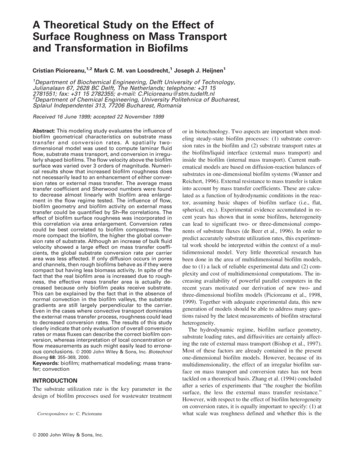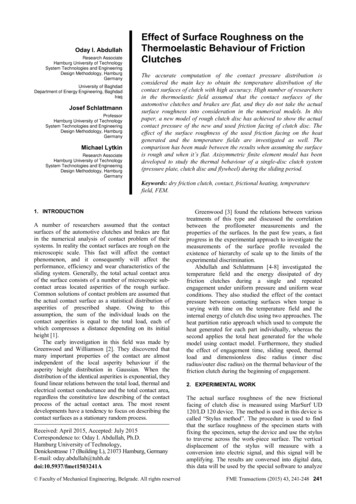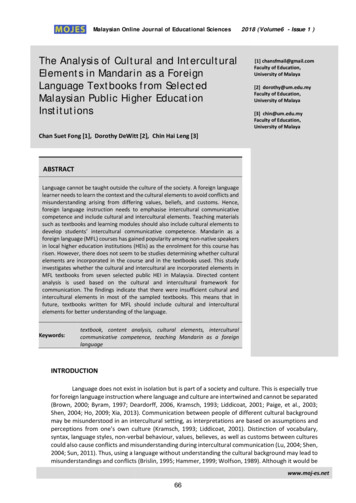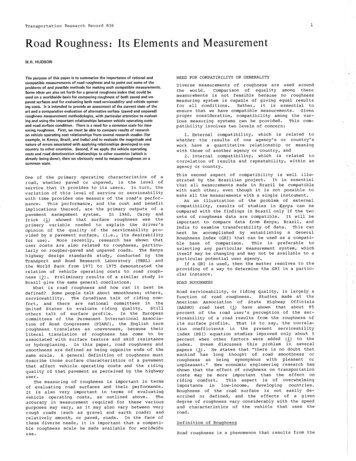
Transcription
Transportation Research Record836Road Roughness: Its Elements and MeasurementW.R. HUDSONThe purpose of this paper is to summar¡ze the ¡mportance of rational andcompatible measurements of road roughness and to point out some of theproblems of and possible methods for mak¡ng such compatible measurements,Some ideas are also set forth for a general roughness index that could beused on a worldwide basis for comparing roughness of both paved and unpaved surfaces and for evaluat¡ng both road serviceab¡l¡ty and vehicle operating costs. lt ¡s íntended to provide an assessment of the current state of theart and a comparative evaluation of alternative surface (paved and unpaved)roughness measurement methodologies, with part¡cular attention to evaluat¡ng and us¡ng the ¡mportant relationships between vehicle operating costsand road surface condition. There is a need fo¡ a common scale for measuring roughness, F¡rst, we must be able to compare results of researchon vehicle operating cost relationships from several research studies (forexample, ¡n Kenya, Brazil, and lndia) and to evaluate the magn¡tude andnature of errors associated w¡th applying relationsh¡p6 developed in onecountry to other countries. Second, if we apply the veh¡cle operatingcosts and road deterioration relationsh¡ps to other countries (which isalready being done), then we obviously need to measure roughness on acommon scale.One of the primary operating characteristícs of aroad, v¿hether paved or unpaved, is the level ofservice that it provides to its users. In turn' thevarÍation of this fevet of service or serviceabilitywith tine provides one measure of the road's performance. This performance, and the cost and benefitirnplications thereof, are the prinary outputs of apavement management systen. In 1960, Carey andlrick (1) showed that surface roughness wâs theprimary variable needed to explain the driver'sopiníon of the quality of the serviceability provided by a pavement surface, (i.e., its desirabilityfor use). .More recently, research has shown thatuser costs are also related to roughness, particularly on rougher-paved and unpaved roads. The Kenyahighway design standards study, con¿luctèd by theTransport and Road Research Laboratory (TRRL) andthe World Bank from 1971 to 1975 demonstrated therelation of vehicle operating costs to road roughness (2). Prefiminary results of a similar study inBraziI give the sarne general conclusions.what is road roughness and how can it best bedefined? Some people tafk about smoothnessi others,serviceability. The Canadians tal-k of riding comfort¡ and there are national comnittees in theUnited States to evaluate riding quality. stiIIIn the Europeanothers talk of surface profile.committees of the Pernanent International Association of Road Congresses (PIARC), the English termroughness translates as unevenness, because theirIiteral translatÍon of roughness has come to beassociated with surface texture and skid resistanceor hydropl-aning. ln this paper, road roughness ândsmoothness are defined as being opposite ends of thesame scale. A general definition of roughness mustdescribe those surface characteristics of a pavementthat affect vehicle operating costs and the ridingquality of that pavement as perceived by the híghwayuser.The measuring of roughness is inportant in termsof evaluating road surfaces and their perfornance.It is also very important in terms of evaLuatingvehicle operating costs' as outlined above. Theaccuracy in measurement required for these variouspurposes may vary, ãs it may also vary between veryrough roads (such as gravel and earth roads) andreì-atively s¡nooth, or paved, roads. rn the face ofthese diverse needs, it is important that a compatible roughness scale be made available for worldwideuse.NEED FOR COI'{PATIBILITY OR GENERÂLITYDiverse measurements of roughness are usedaroundequality anong theseneasurements is not feasible because no roughnessmeasuring system is capable of giving equal resultsfor al-I conditions. Rather, it is essential toensure that we have conpatíble measurements. Givenproper consideration, cornpatibility among the various neasuring systems can be provided. This compatibility involves two levels of concern:1. Extêrnal- compatibitity, which is related towhether the results of one agencyrs or countryrswork have a quantitative relationship or neaningwith those of another agency or country, and2. Internal conpatibility, which is related tocorrelation of results and repeatabifity' within anagency or country.This second aspect of compatibility is well illustrated by the Brazil-ian project. It is essentialthat all measurements made in Brazil be compatibÌewíth each other, even though it is not possible tomake all the measurements with a single instrument.As an iflustration of the probl-em of externalcompatibility, results of studies in -(gnya can beconpared with the findings in Brazil onty if the twosets of roughness data are conpatible. It will beimportant to compare data from Kenya' Brazil, andIndia to examine transferability of data. This canbest be accomplished by establishing a GeneralRoughness Index (cRI) that can be used as a compatib1e base of conparison. This is preferable toselecting any particular measurement system, whichitself may be changing and may not be availabl-e to aparticular potential user agency.If a GRI is used, thên the natter resolves to theproviding of a way to deternine the GRI in a particular instance.the worId.Comparison ofROAD ROUGHNESSserviceability, or riding quality' is Largely afunction of road roughness. Stualies made at the¡\merican Association of State Highway Officials(AASHO) road test (I) have shown that about 95percent of the road user's perception of the serviceability of a road results fron the roughness ofits surface profile. That is to say, the correlation coefficients in the present serviceabí1ityindex (PSI) equation studies improved only about 5percent when other factors were added (! Lo theindex. Hveem discusses thís problen in severalpâpers (3). He states that "there is no doubt thatmankind has long thought of road smoothness orroughness as being synonymous vrith pleasant orunpl-easant." New econonic engineering research hasShown that the effect of roughness on transportationcosts may be more inportant than the effect onriding comfort. This aspect is of overwhelningimportance in J-ow-income, developing countries.Roughness of the road surface is not easily described or defined, and the effects of a givendegree of roughness vary considerably with the speedand cháracteristics of the vehicle that uses theRoadroad.Definítion ofRoughnessRoad roughnessis a phenonenon that results from the
Transportation Research RecordFigure 1. Relation among resonant frequencies of cars. car speed, and pavement surface wavelength.6050to-cPsResononl Frequencyå40E¡oor-cPsôØResononl Frequency-20ootooo*to 20 30 40 50 60 7080Wovelenglh,feelinteraction of the road surface profile and anyvehicle that travefs over that surface. It isexperiencecl by the vehicle, its operator, and anypassengers or cargo. Roughness is a function of theroad surface profile and certain parameters of thevehicle, including tires, suspension, body nounts,and seats as weII as of the sensibilities of thepassengers and driver to acceleration and speed.Hudson and Haas (!) refer to rrpavement roughness"as the "distortion of ride quality." This definition is intended to refer to the road surface,whether paved or unpaved. Safety considerat,ionsinfluence the acceptance of roughness, and theimportant econonic aspects of roughness on vehicleoperating costs should be recognized. For thispaper, the foll-owing definition of road roughness issuggested: the dístortion of the road surface thatcontributes to an undesirable, unsafe, unecononical,or unconfortable ride. A slightly different definition night be as follows: the distortion of theroad surface that imparts undesirable verticalâccelerations and forces to the vehicle or to itsriders and thus contributes to an undesirable,uneconomical, unsafe, or uncomfortable ride.A rider in a vehicle that passes over a roadsurface experiences a ride sensation. This ridesensation is a function of (a) the longitudinal roadprofile, (b) the vehicle parameters, and (c) thevehicle speed. A variation of any one of thesethree variables can make a rough road profile appearsmooth or rough. Therefore, we might say that, froma passenger's viewpoint, roughness is an undesirablecombination of road profile, vehicle parameters, andspeed. Riding characterísÈics of airplanes are alsoaffected by the properties of airfield surfaces andof the aircraft.Vertical accel-erations of suffiaffect safety ofcient nagnitude to criticallyaircraft operations are sometimes obtained over poorsurfaces.Most drivers have experienced the sensation ofimproving a ride on a particular road by eitherslowing down or speeding up. This indicaÈes thatthe road surface profile contains roughness waves orundulations of a length that, vrhen driven over at aparticular speed, produce an excitation in thevehicle at one of the vehicle's resonant frequencies. Since a normal vehicl-e is a simple mechanicalvibrating system n:de up of the mass of the vehicle'the springs on which it ridesr and the shock absorbers, at a particular frequency of vibration orbouncing of any vehicle, the vibrations tend toincrease in amplitude. This is normally called theresonant frequency. The typical passenger car hasresonant frequencies of betv¿een l- and l0 cycles/s(Figure I). This relationship indicates that, at836any particuJ-ar speed of travel, there is a roadprofile wavelength that will excite the vehÍcIe atone of its resonant frequencies and thus causeexcessive vibration or bouncing. rf the amplitudeof that resonant wavel-ength is large, the vibrationor verticaL accelerations imparted to the vehiclernay be quite noticeable. Since vertical accelerations impart significant vertical force, thesewavelengths result in significant forces applied tothe vehicle, which can result in damage to vehiclecomponents and increased operating costs, as wel-I asin an unsafe and unconfortable ride.In general, most vehicles in a particular class(e.9., passenger cars as one class and trucks asanother class) possess si¡nilar characteristics and,for any particular road surface, most vehicles inthe sane class wil-l be driven at about the samespeed. With two of these variables held relativelyfixed, the excitation of the vehicle, and thus theriding quality and vertical forces on the vehicJ-e,becomes primarily a function of the wavelengthcontent of the road profile surface.EvaIuaÈionRoughness evaluation has received considerableattention from many highway and airport agencies inNorth America in the last three decades. Roughnessis the prirnary component of pavement serviceability,and a large nunber of different roughness measuresare ín current use to evaluate such serviceability.Some of the more wideì-y used methods for measuringroughness, correlatÍng measurements, and applyingthe results are outlined elsewhere (5). Many ofthese measure¡nents have involved roughness perception by the highway user as a very important factor,and thus roughness measurements have generallyexcLuded surface texture and microtexture of surfaceaggregates because these are not perceived by theuser to affect riding comfort.The dianeter of surface stone used in gravel andsurface-treated roads that causes noise discernableto the user does have an effecÈ on user perceptíonand affects road roughness by this definitign.Itís not yet known whether these kinds of microvariations affec! vehicle operating costs and safety.RoadProfileauthors, such as Darlington (6) and Carey (7),think that pavement profile does the best job ofcharacterizing roughness. In terms of pavementprofile, roughness can be defined as the sunnationof varíatíons in the surface profile of the pavement. Profiles in this sense do not include theoverall geometry of the road but are 1i¡nited towavelengths Ín the surface of the pavement betweenapproximately 0.031 and 152.4 m (0.1 and 500 ft) inIength. In Darl-Íngtonrs terms, roughness is iltheanalysis of the pavement profile or of the randomsignal known as profile."Carey (7) points out four fundamental uses ofpavement surface profiles or roughness measurements:Many1. To maintain construction quality control-i2. To locate abnormal changes in the highway,such as drainage, subsurface problems, or extremeconstruction def iciencies ;3. To establish a systemwide basis for allocationor road maintenance resourcesi and4. To identify road serviceabifity-performanceIife histories for evaluation of al-ternative designs.fn su¡nmary, then, a road profile is a detailedrecording of surface characteristics, and roughnessor snoothness is a statisticthat su¡nmarizes these
Transportation Research Record836characteristics and provides a measure of ridingquality of a road.Once the surface characteristics of a road aresumnarized, it is essentiãl to establish a scale forthis stãtistic, or su¡nnary, va1ue. This can be donein many ways, as pointed out by Darlington (6).Traditionall-y, the two basic rvays of determiningthis statistic are1. Mechanical integration and2. Mathematical integration or analysis.The first of these methoals is the most commonithat is, the use of some mechanical instrument ordevice such as the Bureau of Public Roads (BPR)Roughometer (Fígure 2) or TRRL Bump Intègrator tomechanically filter and summarize the data in aspecÍfied way. The second method involves recordingthe profile as faithfully as possible and thenanal-yzing or integrating this profile mathematicallywith some standard mathenatical procedure, such asthat outlined by Wa1ker an¿l Hudson (8 ,9), Robertsand Hudson (10r!L) r Quinn (!2) , and Darlington (6) .The most cofnmon methods in current use for mechanical- measurement and summary include the BPR Roughometer (I3) 15), the very similar TRRL Bump Integrator (fg), the Portland Cement Association (
lrick (1) showed that surface roughness wâs the primary variable needed to explain the driver's opiníon of the quality of the serviceability pro-vided by a pavement surface, (i.e., its desirability for use). .More recently, research has shown that user costs are also related to roughness, particu- larly on rougher-paved and unpaved roads. The Kenya highway design standards study, con .
